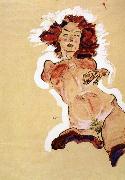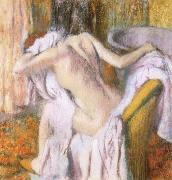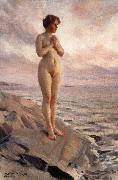
Oil On
Canvas, Real Flavor of Old Masters
|
Eduardo Rosales Gallinas
|
|||
|
|
|||
| Spanish , Madrid, 1836 - Madrid, 1873 | |||
|
|
|||
|
|
Female Nude new3/Eduardo Rosales Gallinas-263936.jpg Painting ID:: 28764 Visit European Gallery |
mk61 1869 Oil on canvas 185x95cm | |
Height Width |
INS/CM |
||
|
X |
|
||
|
|
|||
|
Egon Schiele
|
|||
|
|
|||
| 1890-1918 Austrian Egon Schiele Gallery Egon Schiele (12 June 1890 ?C 31 October 1918) was an Austrian painter, a protege of Gustav Klimt, and a major figurative painter of the early 20th century. Schiele's body of work is noted for the intensity and the large number of self-portraits he produced. The twisted body shapes and the expressive line that characterize Schiele's paintings and drawings make the artist an early exponent of Expressionism, although still strongly associated with the art nouveau movement (Jugendstil). The most important collection of Schiele's work is housed in the Leopold Museum, Vienna. In 1907, Schiele sought out Gustav Klimt. Klimt generously mentored younger artists, and he took a particular interest in the gifted young Schiele, buying his drawings, offering to exchange them for some of his own, arranging models for him and introducing him to potential patrons. He also introduced Schiele to the Wiener Werkstätte, the arts and crafts workshop connected with the Secession. In 1908 Schiele had his first exhibition, in Klosterneuburg. Schiele left the Academy in 1909, after completing his third year, and founded the Neukunstgruppe ("New Art Group") with other dissatisfied students. Sitzender weiblicher Akt, 1914Klimt invited Schiele to exhibit some of his work at the 1909 Vienna Kunstschau, where he encountered the work of Edvard Munch, Jan Toorop, and Vincent van Gogh among others. Once free of the constraints of the Academy's conventions, Schiele began to explore not only the human form, but also human sexuality. At the time, many found the explicitness of his works disturbing. | |||
|
|
|||
|
|
Female Nude new17/Egon Schiele-866225.jpg Painting ID:: 47939 Visit European Gallery |
mk189 1910 | |
Height Width |
INS/CM |
||
|
X |
|
||
|
|
|||
|
Edgar Degas
|
|||
|
|
|||
| French Realist/Impressionist Painter and Sculptor, 1834-1917 French painter, draughtsman, printmaker, sculptor, pastellist, photographer and collector. He was a founder-member of the Impressionist group and the leader within it of the Realist tendency. He organized several of the group exhibitions, but after 1886 he showed his works very rarely and largely withdrew from the Parisian art world. As he was sufficiently wealthy, he was not constricted by the need to sell his work, and even his late pieces retain a vigour and a power to shock that is lacking in the contemporary productions of his Impressionist colleagues. | |||
|
|
|||
|
|
Female nude new18/Edgar Degas-994333.jpg Painting ID:: 48722 Visit European Gallery |
mk191 1880 Oil on canvas 104x98.5cm | |
Height Width |
INS/CM |
||
|
X |
|
||
|
|
|||
|
Anders Zorn
|
|||
|
|
|||
| Swedish 1860-1920 Swedish painter, etcher and sculptor. He was brought up by his grandparents at Mora. As he displayed a precocious talent for drawing he was admitted to the preparatory class of the Kungliga Akademi for de Fria Konsterna, Stockholm, at the age of 15. Dissatisfied with the outdated teaching and discipline of the Academy and encouraged by his early success as a painter of watercolour portraits and genre scenes (e.g. Old Woman from Mora, 1879; Mora, Zornmus.) Zorn left the Academy in 1881 to try to establish an international career. He later resided mainly in London but also travelled extensively in Italy, France, Spain, Algeria and the Balkans and visited Constantinople. However, he continued to spend most of his summers in Sweden. | |||
|
|
|||
|
|
Female Nude new19/Anders Zorn-984792.jpg Painting ID:: 51796 Visit European Gallery |
mk221 1910 Oil on canvas 64.8x43.2cm Sweden 1860-1920 | |
Height Width |
INS/CM |
||
|
X |
|
||
|
|
|||










